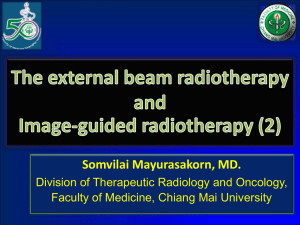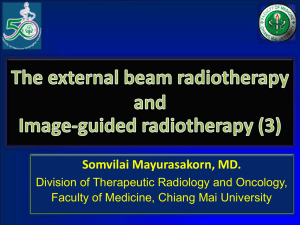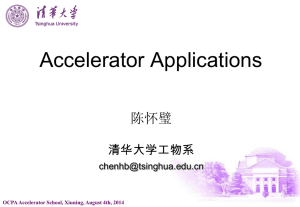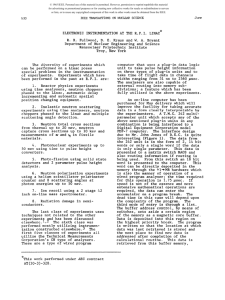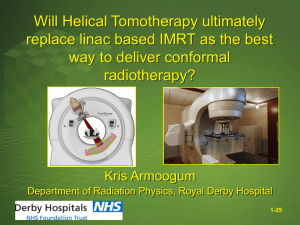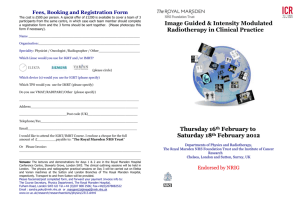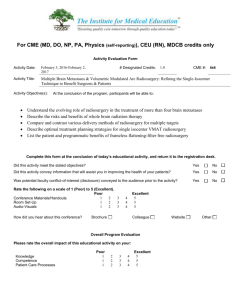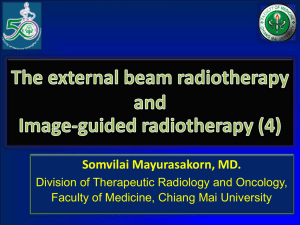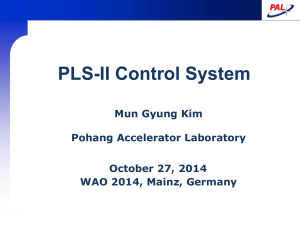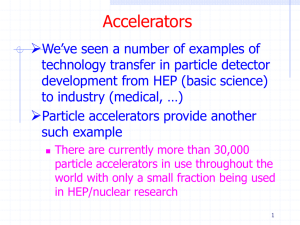PowerPoint - James Crofts Hope Foundation
advertisement
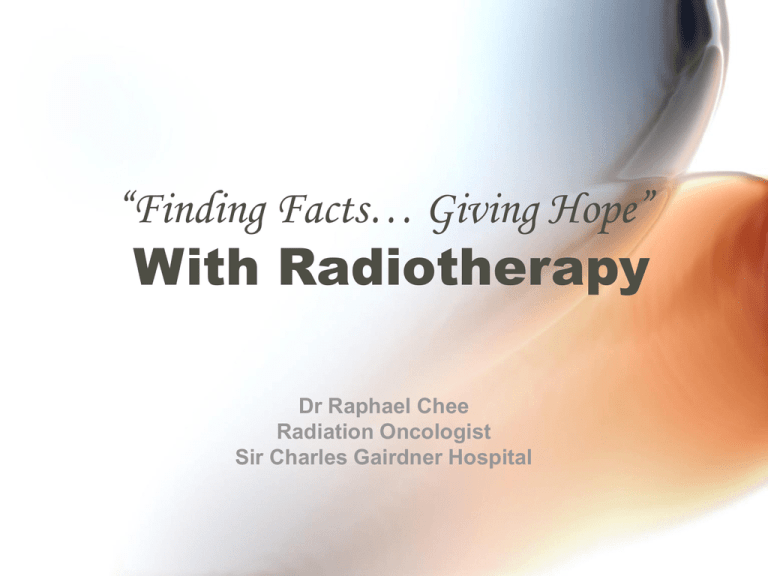
“Finding Facts… Giving Hope” With Radiotherapy Dr Raphael Chee Radiation Oncologist Sir Charles Gairdner Hospital • Role of RT in brain tumours • RT options – Photon (Xray) therapy • Linac • Radiosurgery – Gamma Knife – Linac based • Tomotherapy • Accuray® Cyberknife – Particle (Hadron) therapy • • • • • aka Heavy ion therapy Proton therapy Fast Neutron therapy Boron Neutron Capture therapy Carbon Ion therapy – Pi meson (Pion) therapy Which brain tumours for RT? Malignant • Secondary tumours • Glioma – Glioblastoma – Anaplastic – Astrocytoma – Oligoastrocytoma – Ependymoma Benign • Meningioma • Pituitary Adenoma • Craniopharyngioma • CNS lymphoma • Intracranial sarcoma – Hemangiopericytoma – RMS *Caveats for paediatric patients – Usually international protocol to standardise management, but in general, withhold RT as long as possible to maximise brain development Prognosis Depends on • Tumour type • Tumour grade & staging • Location & size of tumour – Determines extent of surgery possible – Curable or not – Determines performance status/deficits • Patient factors – Age – Co-morbidities – Performance status How it works? External Beam Radiation Therapy (EBRT) Single strand break Double strand break How it works? Apoptosis (cell death) Evolution of RT • 1895 - X-rays discovered (W Röntgen, Germany) • 1895 – first attempt at therapy (breast cancer, Emil Grubbe, USA) • 1903 – first scientific description of the effect of radiotherapy (in lymphoma, Senn & Pusey, USA) • 1952 – first linear accelerator (Stanford, California) • 1973 – CT scan invented (Hounsfeld, UK) • 1990 – first use of CT scan & computers for planning 2D 3D IMRT Aim of RT • To maximise “rogue” cell kill without harming normal cells LINAC – 3D Conformal LINAC – 3D Conformal LINAC - IMRT • Intensity Modulated Radiation Therapy LINAC - IMRT • Allows coverage of target volume AND avoidance of high doses to adjacent organs at risk • But spreads low doses through more volume of normal tissue – (?) Increase risk of radiation-induced second cancers • Less forgiving if target missed – Importance of quality of patient set up – Greater/more complex QA processes required – IGRT is a pre-requisite LINAC - VMAT • Volumetric Modulated Arc Therapy • Upgrade option available on most modern Linacs LINAC - VMAT • More complexity and hence more stringent QA required • Quality of treatment probably not better than static IMRT – But looks better on “paper” • Uses less monitored units (mu) – – – – Thus treatment can be delivered in less time More comfortable for patient Less chance for intra-fraction motion Theoretical reduction in radiation-induced second cancer risks – “Marketing claims” • Competes with Tomotherapy Tomotherapy • First machine in Australia installed at Royal Brisbane & Women’s Hospital 2010 • “Helical arc IMRT” with image-guidance • Highly conformal & precise • Conformal “avoidance” of normal tissues VMAT vs Tomotherapy VMAT vs Tomotherapy Orbits VMAT can deliver treatment plan 30-40% quicker than Tomotherapy VMAT uses less monitored units Tomotherapy plans have slightly better coverage and normal tissue avoidance No head-to-head studies comparing if one is “clinically better” than the other Optic Nerve Pituitary Gland Brainstem Target Volume Radiosurgery – LINAC based Radiosurgery – LINAC based • Frameless – less invasive • Requires real-time IGRT • Requires patient co-operation & compliance Radiosurgery - Gammaknife Radiosurgery - Gammaknife • • • • By Leksell or Elekta About 200 Cobolt sources Requires immobilisation frame Treatment plan conformity similar to others – But cannot fine-tune to place “hot spots” into tumour • Effective working life about 5 years • Treatment time gets longer with increasing age of Cobolt source – Av 30-45 mins for new source • One machine in Macquarie University in Sydney • Estimated $500-1000 more expensive to treat/person vs Linac-based Cyberknife Cyberknife • • • • By Accuray Has real-time IGRT Does not need frame Probably not as accurate as Gammaknife, similar to Linac-based (but no studies available to test/compare) • Long treatment time – about 60min + • Over 150 machines world-wide – Nearest Malaysia, Thailand, India Reminder • Aim of radiation therapy is to maximise lethal effects to cancer cells, without harming normal cells – By conformally treating cancer targets, and by conformally missing normal organs at risk • But uncertainties – Microscopic disease – Changes in internal anatomy during course of treatment – Differences in daily set-up – Tolerances in technology Evolution Rather Than Revolution Improving technology • Hardware upgrades • Better (faster, more accurate) software/planning algorithm • Better screen resolution • More sensitive imaging modalities – CT scan resolution – PET scan – MRI planning scan – IGRT (image guidance) New Revolution? – Improving Conformity Particle Therapy • Little good quality evidence to prove better (or at least not worse) than photon (Xray/gamma) therapy • Advantages are theoretical – High LET (Linear Energy Transfer) thought to be more effective in causing irreparable DNA damage to cells (Xrays have low LET) – But must be certain target is being treated, otherwise high risk of normal tissue toxicity • • • • • Not enough experience Very expensive ventures Currently, treatment facilities need loads of space Need very specialised (& rare) skills Most clinical experience with proton therapy – “tune-able” – Probably has variable LET, depending on energy – Main advantage is dosimetric Proton Therapy Proton Therapy Proton Therapy • Majority machines in North America & Europe (about 25 worldwide) – A few in Japan, one each China & South Africa – Australian Proton Therapy facility in Sydney, approx 2013-2014 • Mixed therapy & research facility • Mounting clinical evidence of therapeutic benefits/efficacy Carbon Ion Therapy • Has one of the highest LET for particle therapy • Does not require O2, so effective in hypoxic cancers – One of the factors for poor radiosensitivity • 3 therapy centres worldwide (Japan, Germany & Italy) – More planned, all in Europe • No clinical studies to suggest better than conventional Xray therapy – Majority of studies are physics-based – Risk of significant toxicity • Very expensive; inadequate data to warrant/risk financial investment Fast Neutron Therapy Fast Neutron Therapy • Limited centres – most built in 1970s; USA, Europe & Japan • Clinical studies showed disappointing results, mainly because of unexpected (at that time due to naïve knowledge of radiobiology) late toxicity – No image guidance – Difficult to guide due to lack of charge in particle, necessitating higher doses • Mostly abandoned as cancer therapy but on-going research – some centres still provide therapy Pi Meson (Pion) Therapy • A pion particle is short-lived (≈26x10-7 sec) • Damage to DNA only occurs at the “end of it’s life” • Is considered as intermediate LET – More “forgiving” to adjacent normal tissue Pi Meson (Pion) Therapy • Currently not available for therapy • First pion centre at Los Alamos, New Mexico closed in 1981 after about 200 patients, second (Paul Scherrer Institute) in Switzerland closed in 1993, after having treated 500 patients • Another has opened in BC, Canada – TRIUMF – But this is only for clinical research, currently – Early results showed no better or worse than conventional Xray therapy Caution • Complexity of treatment increasing – Beware of over-reliance on “blackbox” • • • • Greater number of processes More things can go wrong More mistakes can be made Varying number of commercial hardwares & softwares – May not be compatible • Not all equipment are made the same • QA & Audit important • QA results are site & equipment specific Thank You Brain Tumour Expo 2010 Alternative therapy • UHF (“microwave”) therapy – aka Tronado machine – Thermotherapy – NHMRC review of local practice & available scientific evidence in 2005 reported “no scientific evidence to support the use of microwaves in treating cancer, either alone or when combined with other therapies.” – Audit of Dr J. Holt’s practice • Initial response rate 50% RT alone, 34% RT + UHF, 17% UHF + GBA • Following surgery RR 44% RT alone, 25% RT +UHF, 11% UHF + GBA – No “good scientific studies” to support & explain UHF phenomena on cancer cells – Not accepted as standard of care for cancer treatment
